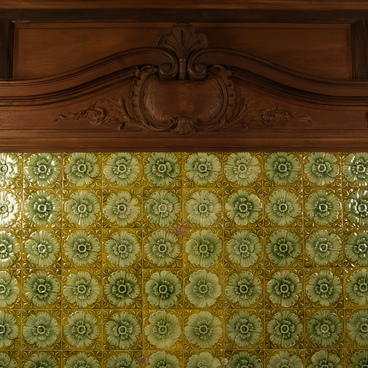This is a mantel clock made of white marble with carved columns. The clock’s upper part is decorated with an ornately shaped finial. The pedestal is comprised of two stepped ovals resting on a rectangular plinth. The clockwork mechanism is lodged in marble casing that is shaped to resemble a neoclassical alcove.
In 1956 the clock that used to be part of the Simferopol Art Gallery collection was transferred into Alupka Palace. In 1992 it came to be part of a just opened exhibition of Massandra Palace.
1700s and 1800s were a very productive time for the French watch industry. A lot of newly built palaces, especially the royal ones, were in need of interior decoration and an essential part of that interior decoration were fireplaces with a traditional clock on a mantelpiece. It should be stressed that it was not just the clockwork but the clock casing design itself that played a role in the late 18th – early 19th century watch industry in France. Clock decoration was customized to blend in with an interior. Small round clockwork mechanisms were routinely lodged into extensive, richly decorated casings. First clocks made of white marble, like the one in the picture, appeared in 1780s.
In the 18th and early 19th century clockmakers and bronzers left their signatures on the clock face. But they were not the only ones engaged in the process: besides them, there were figure-casters who brought sculptors’ fantasies into shape, there were minters who hammered down the imperfections of the cast, there were gilders who covered the items with precious gold leaf, minding the rules of light and shadow and trying to tone down the shining of the surface, and there were chiselers who engraved the clocks with ornaments with their special engraving tools.
Civil unrest brought by the French Revolution of 1789-1794 slowed down the watch industry significantly. Many watchmakers who used to work before the fall of the monarchy were unable to maintain their shops during Revolution and only returned to their craft during the times of Directory (1795-1799) and Consulate (1799-1804). The Consulate-period clocks did not have the same elegance or quality as the ones made in the reign of Louis XVI (1774-1791) or even the Directory, their forms becoming rather stern and square.
In 1956 the clock that used to be part of the Simferopol Art Gallery collection was transferred into Alupka Palace. In 1992 it came to be part of a just opened exhibition of Massandra Palace.
1700s and 1800s were a very productive time for the French watch industry. A lot of newly built palaces, especially the royal ones, were in need of interior decoration and an essential part of that interior decoration were fireplaces with a traditional clock on a mantelpiece. It should be stressed that it was not just the clockwork but the clock casing design itself that played a role in the late 18th – early 19th century watch industry in France. Clock decoration was customized to blend in with an interior. Small round clockwork mechanisms were routinely lodged into extensive, richly decorated casings. First clocks made of white marble, like the one in the picture, appeared in 1780s.
In the 18th and early 19th century clockmakers and bronzers left their signatures on the clock face. But they were not the only ones engaged in the process: besides them, there were figure-casters who brought sculptors’ fantasies into shape, there were minters who hammered down the imperfections of the cast, there were gilders who covered the items with precious gold leaf, minding the rules of light and shadow and trying to tone down the shining of the surface, and there were chiselers who engraved the clocks with ornaments with their special engraving tools.
Civil unrest brought by the French Revolution of 1789-1794 slowed down the watch industry significantly. Many watchmakers who used to work before the fall of the monarchy were unable to maintain their shops during Revolution and only returned to their craft during the times of Directory (1795-1799) and Consulate (1799-1804). The Consulate-period clocks did not have the same elegance or quality as the ones made in the reign of Louis XVI (1774-1791) or even the Directory, their forms becoming rather stern and square.



